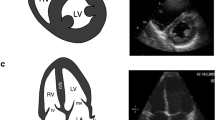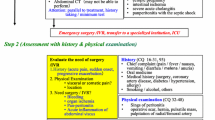Abstract
Objective
To compare contrast computed tomography (CT) for evaluating abdominal and vascular chest injuries after emergency room resuscitation with multidisciplinary management based on bedside procedure (BP), e.g., peritoneal lavage, abdomen ultrasonography urography and, if indicated, CT and/or aortography or transesophageal echocardiography.
Design
Randomized study.Setting: Emergency, critical care and radiology departments in a trauma center.
Patients
The study was performed in 103 severe blunt trauma patients with a revised trauma index<8, admitted over a 16 month period and divided into group 1 (G 1,n=52, CT management) and group 2 (G 2,n=51, BP management).
Interventions
A relative direct cost scale used in our trauma center was applied, and cost units (U) were assigned to each diagnostic test for cost-minimization analysis (abdomen ultrasonograph=7.5 U, peritoneal lavage=8 U, urography=9 U, computed tomography=9 U, transesophageal echocardiography=13.5 U, and aortography=15 U). One unit is approximately equivalent to $ 43.7.
Results
Injury severity score (ISS) was 31.7±15.4 in G1 and 33.8±18.3 in G2. Sensitivity for CT was 90.4% (G1) vs 72.5% for BP (G2) in abdomen (P<0.01) and 60% in chest for evaluating mediastinal hematoma etiology (G1). As Table 2 shows, G1 needed 59 tests for evaluating injuries (1.1±0.3 tests patient) while G2 required 81 tests (1.68±0.8 tests/patient) (P<0.01). The total relative cost was 538 U for G1, 7.04±2.2 U cost/injury and 10.3±3.3 U/evaluation of trauma vs 698 U for G2, 9.84±5.03 U cost/injury and 13.68±8.5 U/evaluation (P<0.05).
Conclusions
This cost-minimization study suggests that CT is a more cost-effective method for the post-emergency room resuscitation evaluation of severe abdominal blunt trauma than the multidisciplinary BP. Chest CT is a screening method for mediastinal hematoma but not for etiology.
Similar content being viewed by others
References
Trunkey D (1991) Initial treatment of patients with extensive trauma. N Engl J Med 324:1259–1263
Danzinger A, Price H (1979) The evaluation of head trauma by computed tomography. J Trauma 19:1–7
Goldstein AS, Sclafani SJ, Kupperstein NH et al (1985) The diagnostic superiority of computed tomography. J Trauma 25:938–946
Liu M, Lee C, Peng F (1993) Prospective comparison of diagnosticperitoneal lavage, computed tomography scanning and ultrasonography for the diagnosis of blunt abdominal trauma. J Trauma 35:267–270
Tocino I, Miller MH (1987) Computed tomography in blunt chest trauma. J Thorac Imaging 2:45–49
Meyer D, Thal ER, Weigelt JA et al (1989) Evaluation of computed tomography and diagnostic peritoneal lavage in blunt abdominal trauma. J Trauma 29:1168–1172
Reis Miranda D (1991) Management of resources in intensive care. Intensive Care Med 17:127–128
Champion HR, Sacco W, Copes WS et al (1989) A revision of the trauma score. J Trauma 29:623–629
Baker SP, O'Neill B, Haddon W Jr et al (1974) The injury severity score: method for describing patients with multiple injuries and evaluating emergency care. J Trauma 14:187–196
Sherck JP, Mc Cort JJ, Oakes DD (1984) Computed tomography in thoraco-abdominal trauma. J Trauma 24:1015–1021
McGonigal MD, Schwab CW, Kauder DR et al (1990) Supplemental emergent chest computed tomography in the management of blunt torso trauma. J Trauma 30:1431–1435
Donohue JH, Federle MP, Griffiths BG et al (1987) Computed tomography in the diagnosis of blunt intestinal and mesenteric injuries. J Trauma 27:11–17
Molin MR, Shackford SR (1990) The management of splenic trauma in a trauma system. Arch Surg 125:840–843
Agee CK, Metzel MH, Churchill RJ et al (1992) Computed tomographic evaluation to exclude aortic disruption. J Trauma 33:876–881
Le Bret F, Ruel P, Rosier H et al (1994) Diagnosis of traumatic mediastinal hematoma with transesophageal echocardiography. Chest 105:373–376
Smejkal R, O'Malley KF, David E et al (1991) Routine initial computed tomography of chest in blunt torso trauma. Chest 100:667–669
Nelson JB, Brestiker MA, Nahrworld DL (1992) Computed tomography in the initial evaluation of ptients with blunt trauma. J Trauma 33:722–727
Spangenberg JF, Van de Poel JH, Iapichino G (1990) Management control in the ICU. In: Reis-Miranda D, Williams A, Loirat P (ed) Management of intensive care. Kluwer, Dordrecht Boston London, pp 103–124
Drummond MF (1986) Cost analysis. In: Drummond MF, Stoddart GL, Torrance GW (eds) Methods for the economic evaluation of health care programmes. Oxford Medical Publications, Oxford, pp 39–71
Author information
Authors and Affiliations
Rights and permissions
About this article
Cite this article
Navarrete-Navarro, P., Vázquez, G., Bosch, J.M. et al. Computed tomography vs clinical and multidisciplinary procedures for early evaluation of severe abdomen and chest trauma — a cost analysis approach. Intensive Care Med 22, 208–212 (1996). https://doi.org/10.1007/BF01712238
Received:
Accepted:
Issue Date:
DOI: https://doi.org/10.1007/BF01712238




